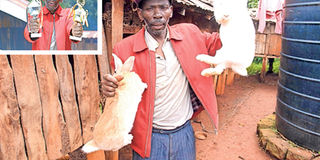Rabbit man wows Nyeri fair

Mwangi Munyiri displays two of the rabbits that he keeps in his home in Mathira, Nyeri County. The farmer had the best buck and doe which won him trophies (inset) during the Central Region Agricultural Trade fair in Nyeri County. PHOTOS | JOSEPH KANYI | NMG
What you need to know:
- Munyiri keeps the New Zealand White, Flemish Giant, California White and a cross of New Zealand White and California White rabbits.
- Munyiri gets bucks for his does from other farmers to avoid inbreeding. He advises farmers to consider having a hutch measuring two-by-two and a half feet for every rabbit.
- The 10-month-old rabbit was four kilogrammes while the Flemish Giant doe was five-and-a-half kilos. It was also 10 months old.
- The New Zealand White matures in six months and can have a litter of 10 to 12 while the California White rabbit gives birth to five to eight kits.
Tens of hutches made of wood, wire mesh and iron sheets litter Mwangi Munyiri’s home in Mathira, Nyeri County. Some rabbits are nibbling at plants while others are in a corner.
Munyiri had the best buck and doe during the Central Region Agricultural fair in Nyeri County. He began keeping rabbits more than 20 years ago but only started benefitting from the venture recently. Traditionally, rearing rabbits was left to boys.
Munyiri keeps the New Zealand White, Flemish Giant, California White and a cross of New Zealand White and California White rabbits.
“I have been doing this for 23 years. Rabbits breed many times and mature fast,” he said. Munyiri bought his first rabbit for a paltry Sh10. He has turned his land into a model farm that attracts hundreds of farmers.
Munyiri gets bucks for his does from other farmers to avoid inbreeding. He advises farmers to consider having a hutch measuring two-by-two and a half feet for every rabbit.
“Kits should be separated to female and male pens when they are weaned two months after birth,” he said. Hutches should be above the ground to protect the animals from predators like dogs, cats and mongooses.
Raising the hutches also protects rabbits from the damp ground. A rabbit goes for Sh300 to Sh500, depending on weight and breed. Before the agricultural fair, Munyiri had more than 100 rabbits.
He has since sold many, leaving him with just a small number. For optimal body weight, Munyiri feeds his animals on sweet potato vines, Napier and maize stalks. During drought, he gives the animals rabbit pellets.
THEY ARE PROLIFIC BREEDERS
“I use grass and other readily available feeds,” he said, adding that he avoids chemicals and supplements. It is for this reason that judges picked his rabbits as the best. The judges were looking at the weight of the rabbits, feeding and purity of the breed.
It emerged that his rabbits had only been fed on organic matter. So how did the judges know that the animals had not been given supplements?
“It was simple. They would place supplements on feeding trays but my rabbits never went for these feeds,” he said.
Munyiri’s New Zealand White breed was top because of its pure white fur. The other rabbits were crossbreeds or their fur was spotted.
The 10-month-old rabbit was four kilogrammes while the Flemish Giant doe was five-and-a-half kilos. It was also 10 months old.
“During the dry season I give them hay and a small mix of supplement feeds,” he said.
The New Zealand White matures in six months and can have a litter of 10 to 12 while the California White rabbit gives birth to five to eight kits.
The adult Flemish giant rabbit can be seven to 10 kilos in four months to a year. It can have five to six young ones.
“I am observing the rabbits to understand the advantages and disadvantages of cross-breeding,” he said.
Robert Thuo, an animal expert, says farmers should know that the animals are prolific breeders.
“A doe that is less than five months old should not be served. Wait until they are mature enough,” Thuo said.





